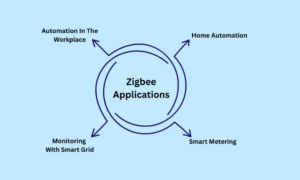Zigbee on the Internet of Things: Introduction
Zigbee on the Internet of Things is also known as Zigbee communication. It is a Zigbee alliance product. It is designed specifically for control and sensor networks based on the IEEE standard for wireless personal area networks (WPANs). This communication standard specifies the physical and MAC layers required to handle many devices at low data rates.
These Zigbee WPANs operate at frequencies of 868 MHz, 902-928 MHz, and 2.4 GHz. The 250 kbps data rate is ideal for periodic and intermediate two-way data transmission between sensors and controllers.
Zigbee is a low-cost, low-power mesh network. It is widely used for controlling and monitoring applications. It has a range of 10-100 meters. Other short-range wireless sensor networks, such as Bluetooth and Wi-Fi, are more expensive. They are also more complex than this communication system.
For master to master or master to slave communications, Zigbee supports a variety of network configurations. It also finds applications in a variety of modes, which helps to conserve battery power. With the use of routers, Zigbee networks have the ability to expand. Thus, it allows many nodes to communicate with one another and form a larger network.
The Zigbee technology is commonly used in the following areas
- Wireless sensor networks
- Automating your home
- Automation in the construction industry
- Embedded sensing is a type of embedded sensing that is used to detect
- There is a smoke warning.
- Control systems for industry
- Intruder alert
What Is Zigbee Technology and How Does It Work?
With digital radios, Zigbee technology allows different devices to communicate with one another. The router, coordinator, and end devices are all used in this network. The primary purpose of these devices is to send instructions and messages. These messages go from the coordinator to single-end devices like light bulbs.
The coordinator is the most important device in this network, and it is located at the system's heart. There is only one coordinator for each network. This coordinator is responsible for various tasks. They select a suitable channel. They then scan it for the most appropriate one with the least amount of interference. It then assigns an exclusive ID and address to each device in the network. This helps in messages and instruction transfer over the network.
Routers
Routers are located between the coordinator and the end devices. They are responsible for routing messages between the various nodes. The coordinator sends messages to the routers. The router stores it until their end devices are in a position to receive them. These can also connect other end devices and routers to the network.
In this network, end devices can control small data by communicating with the parent node. This node can be a router or coordinator. This depends on the Zigbee network type. End devices do not communicate directly with one another. First, all traffic can be directed to a parent node, such as a router. The router will store the data until the device's receiving end is in a position to receive it. End devices help to request any messages from the parent that are currently pending.
Applications Of Zigbee
A correspondence link is used in assembling and manufacturing businesses. This helps to track various parameters and basic types of equipment. As a result, Zigbee lowers the cost of communication. Also, it improves the control procedure for improved consistency.
Zigbee is ideal for controlling home apparatuses remotely. It can control devices such as lighting, machine control, heating, and cooling system control. It can also control health equipment activities and control and reconnaissance.
Zigbee remote tasks in smart metering include energy utilization reaction, estimation support. It also provides security against power theft, among others.
In this brilliant matrix, Zigbee's tasks include remote temperature monitoring, fault detection, and receptive power management.
Zigbee on the Internet of Things: Advantages
Thousands of nodes can be connected using Zigbee technology. A single network can support up to 65000 nodes. This contributes to the transmission range's continued expansion. This is possible in a large space, a building with many floors. It also finds application in a house with various physical divisions.
Suitable For Low-Power Devices
The Zigbee technology is ideal for low-power devices. It supports small battery-operated smart devices, object tags, sensors, and other similar devices. These small devices are suitable for this technology because it does not need a lot of bandwidth. It can also replace Wi-Fi and Bluetooth.
A mesh network is what Zigbee is. As a result, Zigbee has a network that is expandable. This expansion is similar to mesh networking. When compared to a single router, Wi-Fi, or Bluetooth, it provides more stability. The content can expand because individual nodes act as repeaters or wireless routers in this technology. Also, because the technology supports multiple nodes, it's easier to expand the network.
The Zigbee technology's structure is very adaptable. It has a simple installation process and is also less expensive. This technology has a short working period and long battery life. This also results in less power consumption.
The Zigbee technology is simple to track and control. It is simple to maintain with the help of a remote because it is mainly used for home appliances. There is no central controller in place. Loads of this technology are distributed evenly across the network.
Zigbee on the Internet of Things: Disadvantages
Network interference is a common problem with Zigbee technology. This is due to the network's overcrowding and channel noise. One of the main reasons for this is because it uses the 2.4 GHz band. This band is also used by Bluetooth devices, cordless phones, microwaves, and other wireless devices. The technology is susceptible to interference.
The Rate Of Transmission Is Low
Zigbee is designed for low-rate data transmissions. Because of this, the technology used in it has a low bit rate. As a result, it has a lower transmission rate than Bluetooth and Wi-Fi. It is also unsuitable for high-speed data transmission.
The security risks associated with Zigbee technology are many. Intentional interferences can result in the loss of network services. It may also cause data theft from a node or the theft of an entire node because it is susceptible to interferences. A hacker can also gain access to a node. Hackers can even take control of it without permission. It also has issues with compatibility.
The installation of Zigbee technology can be costly. There are many reasons for this. The cost of Zigbee implementation changes with the size and range of the network. The availability of compatible products and devices has an impact on the price. The cost of a particular application is also influenced by the technology's complexity.
The Zigbee technology can replace the standard wireless communication Z-Wave. When compared to Zigbee, Z-Wave wireless communication has a longer range. It also has better reliability and stability. It is more stable because it operates on the 908 MHz frequency band.
Conclusion
The characteristics of ZigBee set it apart from other possible IoT protocols. Thus allowing it to carve out its own niche in the market. Because of its mesh topography, it can handle longer distances than Bluetooth Low Energy. Also, its low energy consumption makes it more IoT-friendly than Wi-Fi.
After the chips wide usage in homes, the next step will be to include a ZigBee chip in smartphones. The primary method of communicating with sensors in the home is through their smartphone or tablet. Having such a chip integrated inside would put it in the hands of millions of smartphone owners. The users could turn it on at the touch of a button.
ZigBee radios find applications in homes via a hub, router, or set-top box. This makes their adoption by homeowners reliant on service providers and early adopters of products. Only after analyzing its pros and cons can one come up with a decision to install the Zigbee network.
You may also like to read:
Security Issues Concerning IoT and Their Solutions
Edge and Cloud Computing for IoT and Their Key Roles






